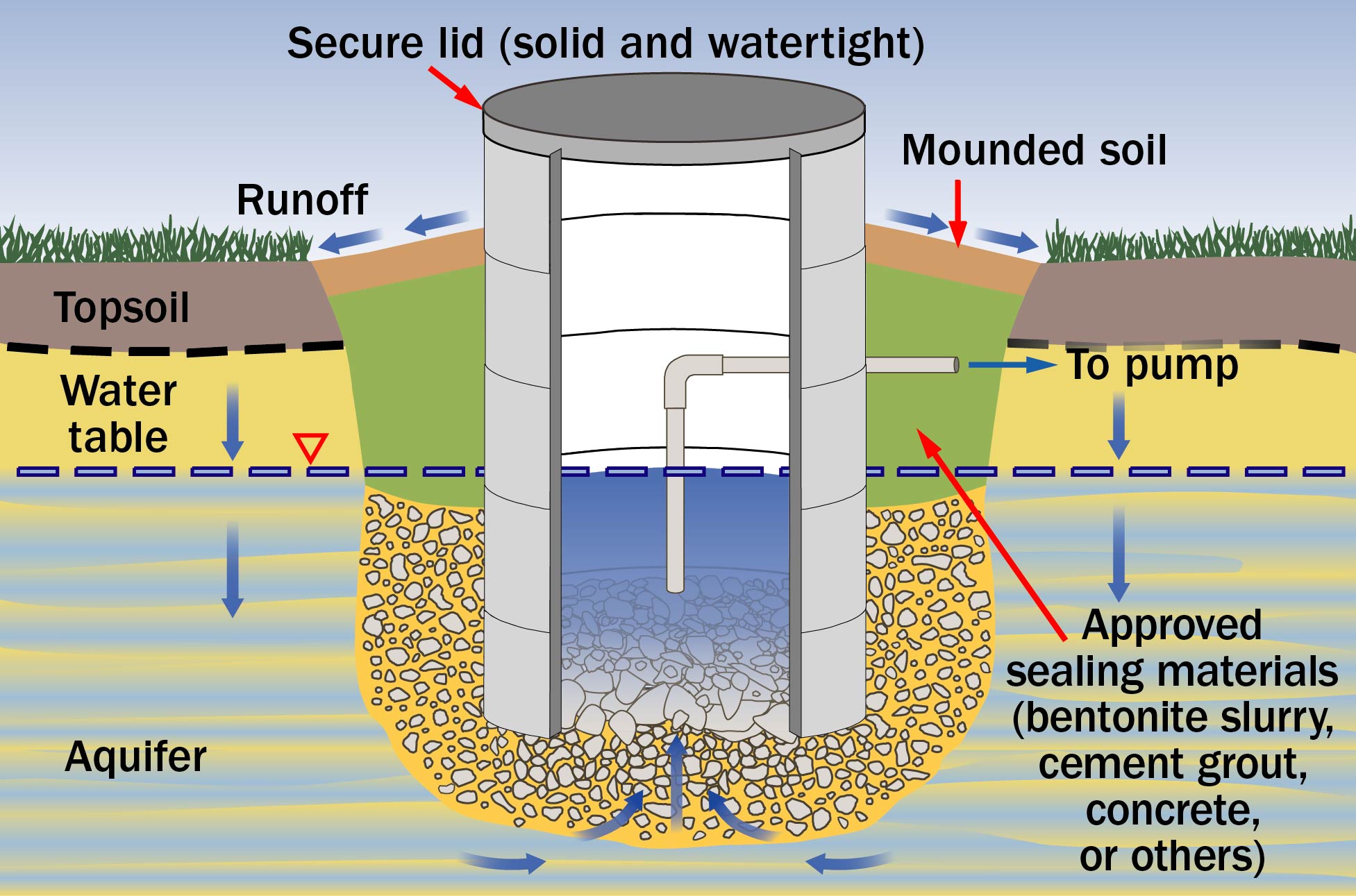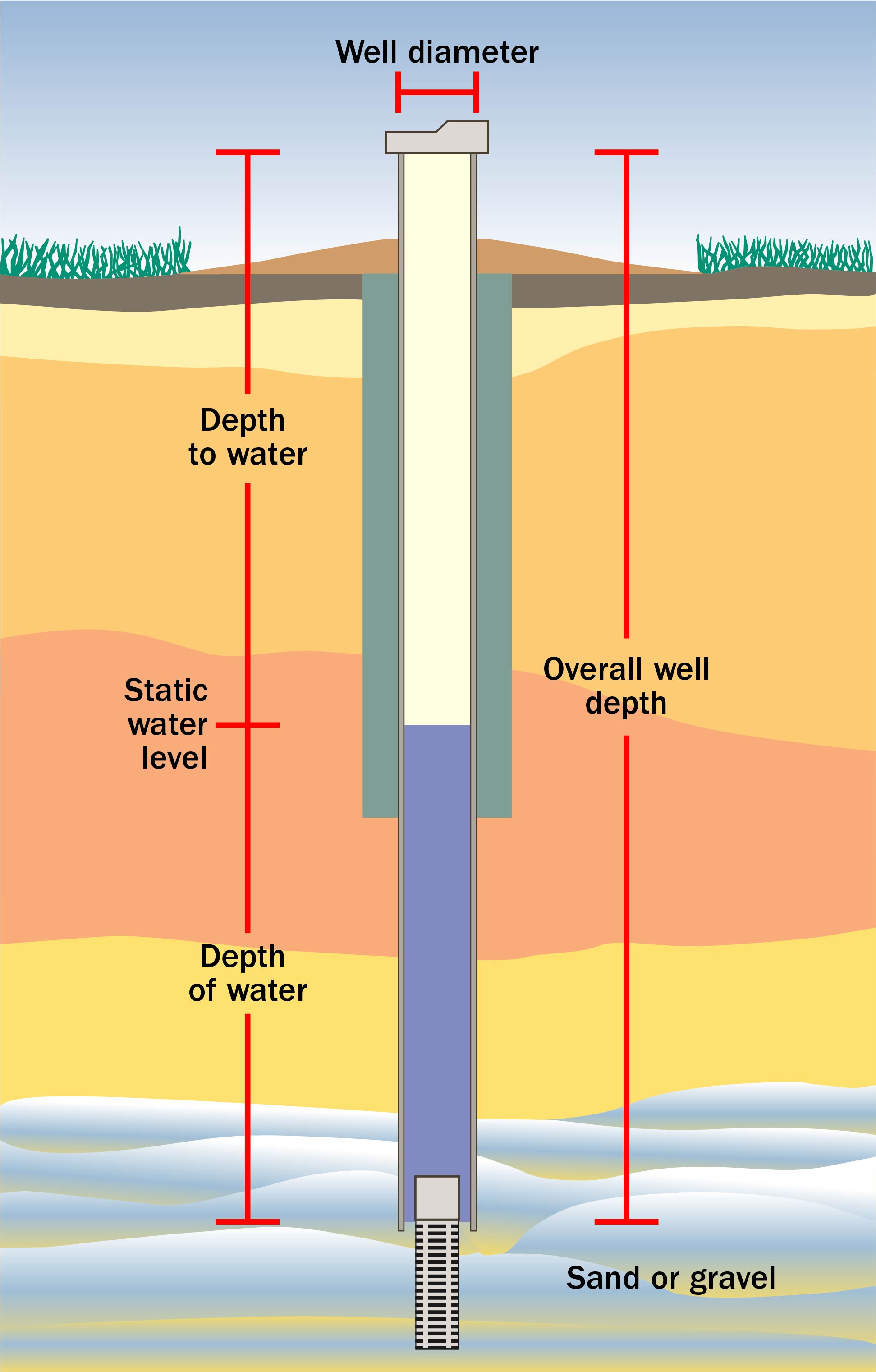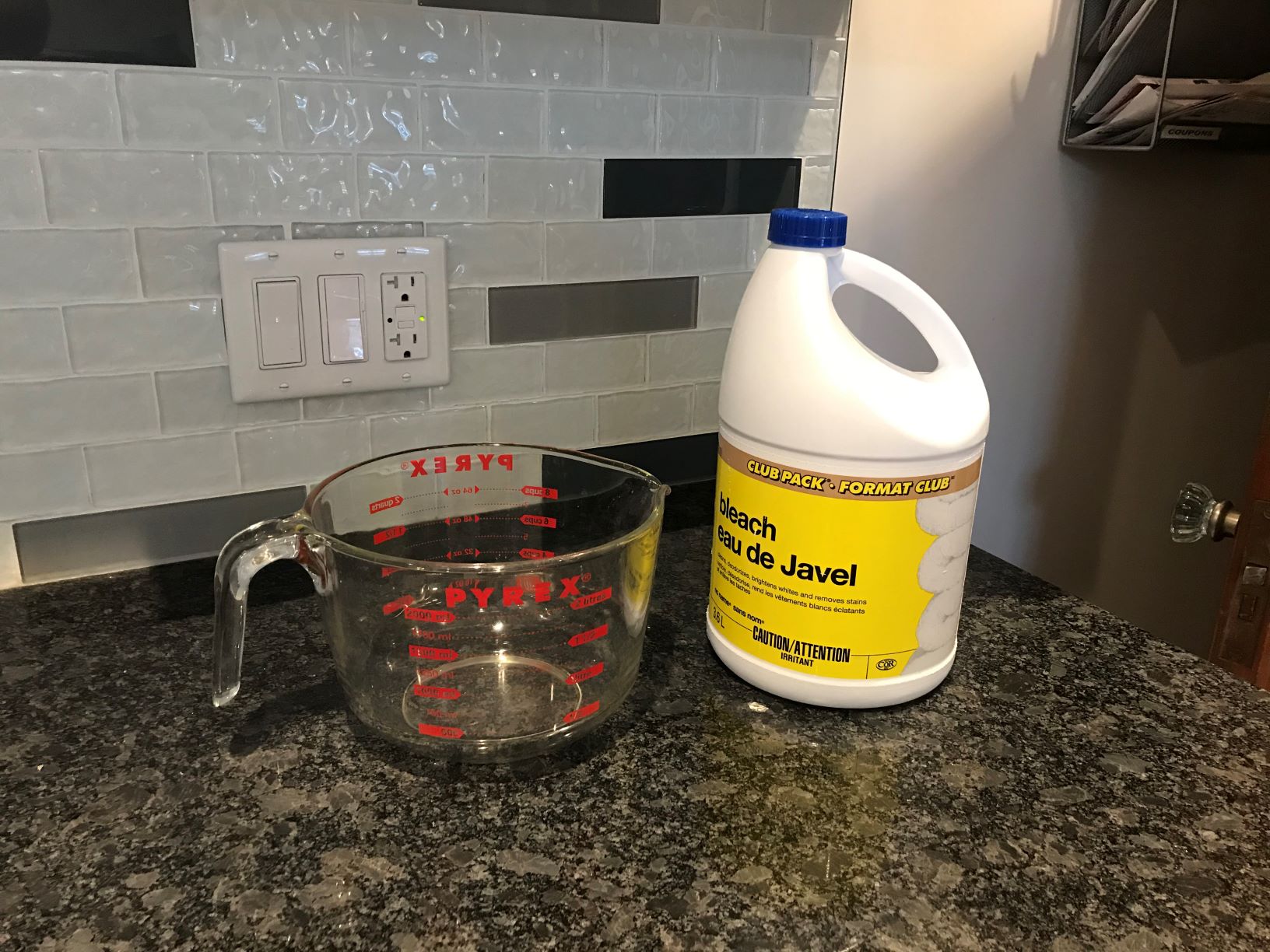Disinfecting private water wells
Learn how to disinfect your private water well. This technical information is for Ontario farmers and rural residents.
ISSN 1198-712X, Published June 2021
Introduction
All Ontarians can play a role in protecting groundwater quality and quantity. This is the sixth fact sheet of seven in a series that will help Ontario’s farmers and rural residents learn more about groundwater. This fact sheet discusses how to disinfect your private water well if you have water quality concerns.
The OMAFRA fact sheets in the groundwater series are:
- Understanding groundwater
- Managing the quantity of groundwater supplies
- Protecting the quality of groundwater supplies
- Private Rural Water Supplies
- Highly vulnerable water sources
- Disinfecting private water wells
- Testing and treating private water wells
Groundwater is a valuable resource for farm and rural families, farming (livestock watering, irrigation, wash water, etc.) and rural businesses, in some situations it may be the only water source. When living in a rural area, it is important to understand what actions to take to ensure that your water supply is suitable for potable use.
To determine if your water supply is suitable for potable use (there is no significant evidence of bacterial contamination), submit water samples to Public Health Ontario or to your local public health unit. Information about testing the water quality of your private water well is presented in the OMAFRA fact sheet, Testing and treating private water wells.
Groundwater quality and private water wells
Some groundwater sources are more vulnerable than others. These include shallow groundwater aquifers that have an inadequate depth (less than 3 m (10 ft)) of protective overlying soil and aquifers that are under the direct influence (direct and rapid movement) of surface water. Wells can also be vulnerable, including those where a defective casing allows direct entry of surface water, those located in a low area prone to ponding and/or flooding and those near or downslope (down-gradient) of a potential contaminant source.
Information about more vulnerable water sources is presented in the OMAFRA fact sheet, Highly vulnerable water sources. Information about groundwater terms and concepts is presented in the OMAFRA fact sheet, Understanding groundwater.
The risk of water quality problems with a groundwater source is directly related to the depth of the soil overlying the aquifer, the type of well, the state of repair of the well, the depth of the well and how close the well is to potential sources of contamination. The general rule is the deeper the well, the longer it will take for surface water to filter down through the overlying soil before entering the well, which increases the potential for microorganism filtering and reduces the risk of contamination. The risk of contamination also decreases as the distance between the well and potential contamination sources increases.
A well is designed to draw water from an aquifer while also keeping contaminants and surface water out. Proper well construction ensures that surface water cannot directly enter the well and will instead infiltrate and pass downward more slowly through the soil before it enters the well (Figure 1). A well casing with proper height and a secure lid prevents direct entry of surface water, dust, debris and vermin. Mounded-up soil around the wellhead directs water away from the well casing, and the watertight grout (sealing material) in the space around the well casing prevents surface water from easily moving down along the side of the well casing and into the groundwater, or directly into the well.

Figure 1. A properly constructed large-diameter well keeps surface water and contaminants from the well.
In Ontario, Regulation 903 (the Wells Regulation). prescribes requirements for the construction, maintenance and abandonment of private water wells. The Wells Regulation requires that the well owner must maintain the well in a way that prevents the entry of surface water and other foreign materials into the well. Proper construction and maintenance of a well will help prevent it from becoming a pathway for surface water and contaminants to reach the groundwater. If a well is no longer used, it must be properly abandoned (plugged and sealed). The requirements for construction change periodically, and it is recommended that well owners refer to the current requirements under the Wells Regulation.
Testing your water supply
If your drinking water is supplied by a well on your property, you must do all you can to make sure the water is suitable for potable use, now and for years to come. You are responsible for getting your well water regularly tested, at least three times per year is recommended, and more where necessary. It’s a proactive step you can take to make sure the water supply for your home, farm or rural business is suitable for potable use. That way, you can be more confident that what you’re drinking is free from bacteria.
How often should you test? Regularly test wells to establish a pattern to determine how much your water quality changes and how often you need to test. Some wells are fairly stable and won’t need to be tested as often, whereas others will be more variable and must be tested frequently. Properly constructed deeper wells tend to have more stable static water levels and water quality than shallower wells. Also, more testing is required when unusual events occur, such as during the spring melt.
Regular testing will help you know if your well is suitable for potable use. Testing for bacteria in well water samples is offered as a service (no charge) to owners and users of private wells. Sample bottles are available from Public Health Ontario and local public health units. The OMAFRA fact sheet, Testing and treating private water wells presents additional information about ways to test the water quality of these sources and options that are available for treating the water from these sources.
Public Health Ontario testing only determines if a water supply is suitable for potable use (there is no significant evidence of bacterial contamination). Public Health Ontario does not test for other contaminants such as chemicals. This means that even if your results show there is no bacterial contamination in your drinking water, it still may be unsafe to drink. Information about testing for other contaminants in groundwater is presented in the OMAFRA fact sheet, Protecting the quality of groundwater supplies.
Water can also contain dissolved chemicals that can make you sick. The dissolved chemicals may come from naturally occurring minerals or from spills of manufactured substances. There can also be changes in “aesthetic parameters” (such as, taste, colour or odour). Additional information about naturally occurring chemicals in groundwater is presented in the OMAFRA fact sheet, Protecting the quality of groundwater supplies. If you have a concern about chemicals in the water, consult the Ministry of the Environment, Conservation and Parks list of accredited laboratories that test water for specific contaminants.
If your water well produces water that is not potable (for example, water tests indicate significant evidence of bacterial contamination), consult your local public health unit for help in interpreting the test results and get guidance on what measures to take to safeguard your drinking water. Information to help you interpret your water test results is also provided in the OMAFRA fact sheet, Testing and treating private water wells.
Note: Guidance for disinfecting a private well may vary between agencies, depending on why the existing well is being disinfected. The guidance provided in this fact sheet is a general minimum to ensure your water supply is suitable for potable use. Your local public health unit may provide different advice for disinfecting an existing well, depending on the age and type of well or other local conditions.
Well construction a problem
If your well has repeated adverse water quality test results, there are several steps you can take to ensure the construction of the well is not the source of your water quality problem before looking at water quality treatment options.
The first step is to conduct a visual inspection of your well. The area around it should be:
- clear of any potential contaminant sources (such as animal droppings, lawn care products and gardens)
- mounded up around the outside of the well or well pit so that rainwater is directed away
- sloped away from the well to direct surface water drainage away and to prevent ponding of water near the well
Mounding earth immediately around the casing will direct surface water away from the well. This will help reduce the risk of surface water ponding at the well site and reduce the potential for surface water to migrate down the side of the well casing into the well.
Next, once you’re satisfied the area around your well is okay, take a good, close look at the well itself. If It is an older well, make sure the cap and the sealant around the well casing aren’t cracked or damaged. If they are, fix or replace them right away. Information on conducting an inspection of your well, including a well maintenance checklist, is presented in the OMAFRA fact sheet, Protecting the quality of groundwater supplies.
If the source of the problem can’t be detected, consult a licensed well contractor for help identifying the source of the problem and how best to deal with it. You can save a lot of money by doing this instead of rushing out to buy a water quality treatment device that may be expensive to install, operate and maintain. And it may not eliminate the source of your problem.
Disinfecting the water supply
Disinfect a well or water system each time it is opened for repairs or measurement. The purpose of disinfection is to ensure that minimum chlorine levels are distributed throughout your drinking water system for a period of time to adequately kill bacteria. Prior to disinfection, ensure you have a back up water supply for at least 12 hours.
Steps for disinfecting the private well (also known as shock chlorination)
- Measure the diameter of the well (Figure 2).
- Measure the well depth and the static or resting water level, then calculate the depth of water in the well
- If you are not able to measure the well, check your water well record for this information.
- Calculate the amount of bleach needed (Figure 3). Table 1 gives the volume of bleach needed for common metric well sizes for each 3 m of water depth. Then, measure out the correct amount of bleach into a bucket containing water and pour the mixture into the well. Diluting bleach in a bucket of water will help with distribution and mixing in the well. Take care when working with chlorine bleach, avoid getting it in your eyes or on your skin or clothing. Contact your local public health unit for additional advice on how to handle it carefully.
- Before adding chlorine to the well, remove or bypass any carbon filters that are in the system for water treatment, otherwise these filters will remove the chlorine from the water, and any pipes beyond the filter will not get disinfected. Replace with new filters after chlorination to avoid reintroducing bacteria into the system.
- If possible, mix the water in the well some more. This can be accomplished by attaching a hose to a tap, running water from the well through the hose and back into the well.
- Run water at every faucet in the house (and barn if you have one) until a strong chlorine odour is detected. Be aware that your nose may lose its ability to detect chlorine.
- If there is no chlorine smell or it is very weak, add more bleach to the well and repeat Step 6.
- Drain the water heater, turn off the heat source, fill with chlorinated water or turn hot water tap on until a strong chlorine odour is detected.
- Backflush the water softener and all water filters (except carbon filters), if recommended by the manufacturer.
- Let the chlorinated water stand in the system for at least 12 hours.
- Clear chlorine from the well by running an outside hose to the ground surface. Then, run clear water through the faucets (both hot and cold) until the water no longer smells of chlorine.
- Avoid putting too much chlorine into the septic system because the bacteria needed for septic decomposition may be killed.
- Do not drink the water without boiling it until test results show the water is suitable for potable use.

Figure 2. Key measurements for disinfecting a well.

Figure 3. Liquid bleach can be carefully administered to disinfect a private water well.
Table 1 gives examples of the volume (in millilitres) of unscented household chlorine bleach required for every 3 m (10 ft) of water depth for common metric well diameters. The calculations are based on the concentration of commonly available unscented 5.25% household chlorine bleach needed to achieve a chlorine residual of 50 parts per million (ppm). Different volumes will be needed for different forms and concentrations of chlorine.
| Casing diameter (widest distance across the top of the well casing) | Bleach volume (mL of 5.25% household bleach for every 3 m of water depth in well) |
|---|---|
| 100 | 30 |
| 150 | 60 |
| 200 | 100 |
| 250 | 200 |
| 300 | 250 |
| 400 | 400 |
| 500 | 650 |
| 600 | 900 |
| 900 | 2,000 |
| 1,200 | 3,600 |
Calculating the volume of bleach required
The formula for determining the amount of 5.25% bleach (most common) to reach the desired treatment level for other well diameters and depths of water (millilitres) is:
volume of bleach required = (0.785 x D x D x H)/1,000
D = inside diameter of the casing (mm)
H = depth of water (metres)
For example: If there are 6 m of water in your well and it has a casing diameter of 100 mm, you would add 60 mL (2 x 30 mL) of 5.25% unscented household bleach.
This formula was derived from technical information provided in Chapter 8, Well Disinfection, of the Ministry of the Environment, Conservation and Parks online publication Water Supply Wells: Requirements and Best Practices.
Contact your local public health unit for additional information or to answer further questions on how to disinfect your well.
This fact sheet is consistent with, but does not reflect the full detail, of the Wells Regulation. For assistance with the Regulation, seek advice from the Ontario Ministry of the Environment, Conservation and Parks (MECP) through the Wells Help Desk. Call 1-888-396-9355 or e-mail wellshelpdesk@ontario.ca.
Resources
- if you have suspected problems with your well that involve surface water, human or animal waste
- for a water sample bottle for indicator bacteria testing
- for help interpreting your water quality sample results
Public Health Ontario Laboratories:
- for a water sample bottle for indicator bacteria testing
- interpretation of water sample test results
- to perform water testing in Ontario
- if you have concerns about chemicals in the well such as sulphur or nitrates
- if you are concerned that your well is improperly constructed, or requires upgrading or maintenance
- ensure they are licensed to provide this service
Ontario Ministry of the Environment, Conservation and Parks:
Ontario Soil and Crop Association:
Information on different actions that can be taken to protect the quality of groundwater and your drinking water supply is provided in the Canada-Ontario Environmental Farm Plan workbook and associated Infosheets.
This fact sheet was written by Dr. Hugh Simpson, program analyst (retired), OMAFRA; Jim Myslik, JPM consulting. It was reviewed by John Warbick, engineer, crop systems & environment, OMAFRA. Recommendations were also provided by technical experts at the Ontario Ministry of the Environment, Conservation and Parks.